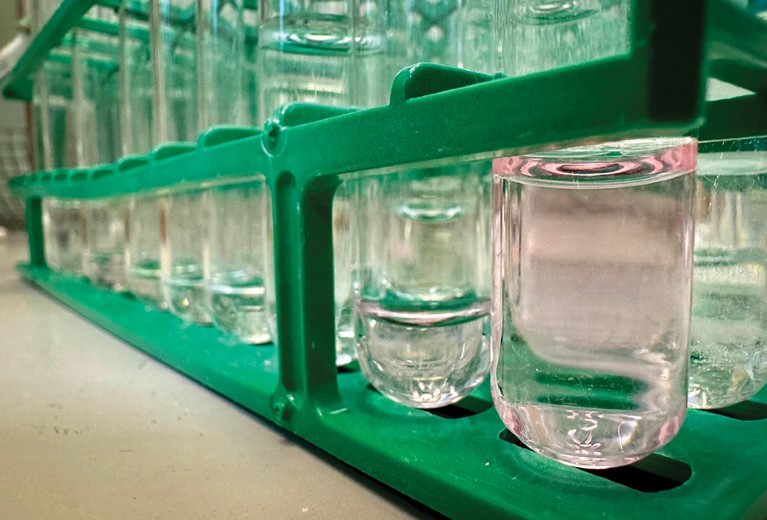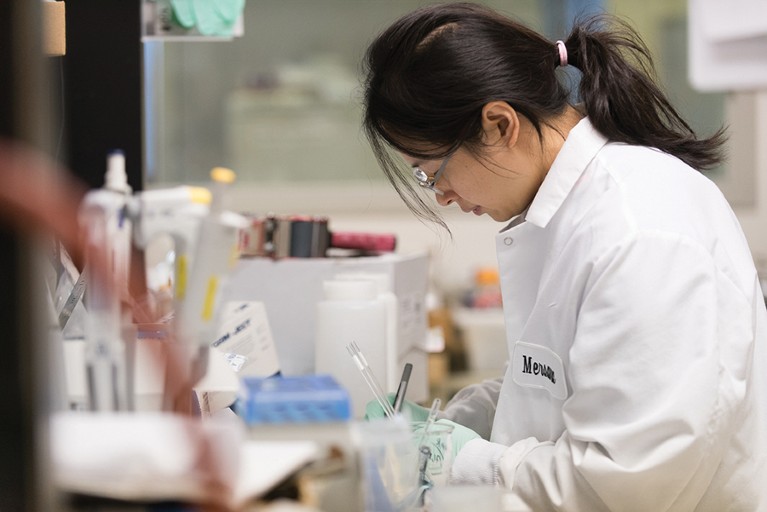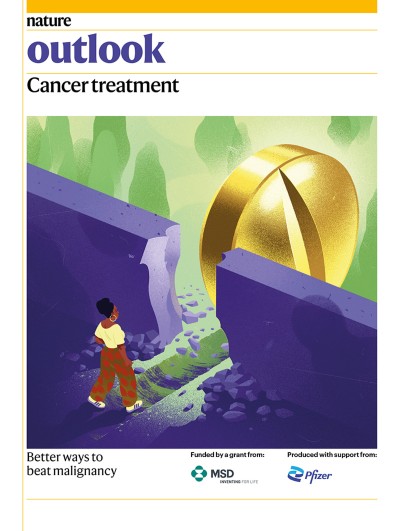
Test tubes containing a compound that is used to link antibodies and drugs together.Credit: David R. Spring
Chemotherapy drugs are well suited to killing cancer cells, but they’re bad at killing only cancer cells — the destruction of healthy tissue has been an inevitable outcome. This toxicity is why chemotherapies come with significant side effects, pushing some people to discontinue the drugs in favour of palliative care.
Decades of work to develop less burdensome alternatives are now coming to fruition. One approach is to use even more potent anticancer drugs, but package them in a way that makes them more selective of the cells they kill — meaning they are both more effective and have fewer side effects as compared with conventional chemotherapy.
Nature Outlook: Cancer treatment
This is the promise of antibody–drug conjugates (ADCs), which consist of three key parts. The first is an antibody, which is engineered to dock at specific receptors on a cancer cell’s membrane. The second is a highly toxic cancer-killing drug. And the third is the chemical scaffold that connects the antibody to the drug.
“It’s a simple structure on paper,” says Kyoji Tsuchikama, a medical chemist at the University of Texas Health Science Center at Houston. But because of the delicate balance between efficacy and safety, he adds, “we’ve needed a complex understanding of cancer biology to make them”.
More of a fizzle than a bang
This approach to cancer therapy has been a long time in the making. Technological innovations in the 1970s made it possible to strike tumours precisely with antibodies. A decade later, researchers began clinical trials for the first ever ADCs, but the results were subpar.
The first generation of ADCs held no advantage over conventional chemotherapy: they were ineffective and highly toxic, causing fatigue and alopecia, as well as nerve damage that lead to pain and numbness. It wasn’t until the turn of the millennium that scientists honed the design of ADCs sufficiently for the US Food and Drug Administration (FDA) to approve the use of one, to treat myeloid leukaemia. Another decade passed before the next ADC gained approval, this time for Hodgkin’s lymphoma. Then, in 2013, the first ADC to target a solid tumour was approved for breast cancer1. There are now 11 FDA-approved ADCs on the market for at least 20 specific indications, with many more in the pipeline2.
This rapid development of ADCs is thanks to research that has refined antibody design, expanded payload options and improved the linking scaffold structures. Scientists have been working to determine the best combination of these components, spurred on by renewed interest in ADCs from investors and pharmaceutical companies.
ADCs still have their imperfections. “We do still see toxicity and sometimes that’s because of improper design,” says Tsuchikama. “It’s not like they cause instant death, but in terms of patient quality of life, it can be disruptive.” For example, if ADCs mistakenly shed their payloads in normal cells or in the bloodstream, rather than directly into the cancer cells, then the kinds of side effect that typify conventional chemotherapy are likely to persist.
As with most new cancer treatments, ADCs are expensive. It’s perhaps not surprising, therefore, that drug companies are betting a lot of money on them in anticipation of handsome returns. Market research analysts valued the ADC market at US$9.25 billion in 2022, and forecast it to increase to $20.5 billion by 2030. One 2023 paper estimated that it costs about €120,000 ($128,000) to treat someone with breast cancer with ADCs for one year3. The authors of the study question whether insurance companies and public health-care systems will be prepared to spend that kind of money on the millions of people diagnosed with the disease each year.
But that seems not to have dampened the enthusiasm of large pharmaceutical companies, which are on something of a spending spree, buying up smaller ADC specialist companies. AbbVie, a US pharmaceutical firm, announced in November last year that it had agreed to buy the biotechnology company ImmunoGen and its ADC programmes for $10.1 billion. In the same month, global drug company Bristol Myers Squibb acquired Orum Therapeutics’ ADC effort for $100 million and agreed to pay a further $180 million if the drug proves successful.
Some studies estimate that there are at least 100 ADCs undergoing clinical trials, but that might be understating the scale of the activity2. “I’ve heard people quoting as many as 900 ADCs in clinical trials,” says David Spring, a chemist at the University of Cambridge, UK, who works on ADC structures.
In a bid to reach this promised land of abundant, effective and profitable ADCs, scientists have turned their attention towards minimizing the lingering toxicity of these therapies. “There was a slow burn to start with, but all of the problems are solvable,” says Spring. “I’m very optimistic. It’s a massive opportunity.”
Adjusting the payload’s focus
One way to achieve lower toxicity is to reduce the number of drug molecules that are part of each ADC, but that would be a trade-off with efficacy. Most current ADCs are designed to carry between one and eight drug molecules per antibody. Conventional wisdom favours a mid-range ratio. That’s because it offers the promise of a high enough dose to kill cancer cells, but not so high that healthy cells are overly threatened, says Timothy Lowinger, chief science and technology officer at Mersana Therapeutics in Cambridge, Massachusetts.
But if the target cancer cells don’t express several of the receptors that an ADC binds to, then a higher drug-to-antibody ratio might be needed, argues Lowinger. Conversely, if the surface of a cancer cell is peppered with an overabundance of the receptors, then a lower ratio might do the trick4. It’s about finding the payload that is just right for the type of cancer that you’re trying to thwart, says Lowinger. “Let the target inform the ideal drug-to-antibody ratio.”

Scientists at the biotechnology firm Mersana Therapeutics in Cambridge, Massachusetts, are researching antibody–drug conjugates.Credit: Mersana Therapeutics
In addition to tinkering with drug ratios, Mersana is trying to reduce toxicity by altering the chemistry of the ADC structure to ensure that it doesn’t loiter in a person’s bloodstream in its active state after its work is done. “We’ve built in a metabolic trigger — a small portion of the molecule that gets cleaved off by cellular enzymes,” Lowinger explains. This happens when the payload enters a cancer cell and creates a negative charge that stops the drug from getting out again. “It stays where you want it to stay when the cancer cell dies”, he says, reducing the risk of the ADC going on to inflict collateral damage on healthy cells.
Mersana’s ADC that operates in this way, known as XMT-1660, is undergoing phase I clinical trials for the treatment of adults with advanced or metastatic triple-negative breast cancer, which has more-limited treatment options than other forms of the disease; initial results are expected this year.
Resetting the target
Spring is tackling a different aspect of the toxicity conundrum: the tendency of ADCs to shed their toxic payloads before they even reach a cancer cell. “It’s almost a universal problem with clinically approved ADCs,” says Spring.
It often occurs because healthy cells have the same target receptor on their membranes as do cancer cells. That confuses the ADC, causing it to unload its toxic cargo into the wrong cells. Such misplaced deposition of the drug is “the biggest factor as to why you get systemic toxicity”, Spring says.
That’s why he and his colleagues are questioning whether ADCs even need to enter cancer cells at all. His alternative would see ADCs release their payload only when they’re in the vicinity of tumours. That might mean, in theory, that some ADCs will end up targeting healthy cells that are in the immediate vicinity of tumours, but not in a quantity significant enough to cause side effects.
The good news for efforts to design such proximity-triggered ADCs is that cancer cells create a distinctive chemistry in their environment; they exhibit oxidative stress from oxidation–reduction (redox) reactions in which some substances lose electrons, and some substances gain electrons. “Our release method is triggered by the high redox environment,” Spring says. “It responds to the chemical environment of cancer and so you end up with an elevated concentration of the drug” in and around the tumour. The hope is that this method will be able to target cancer cells more specifically than can the conventional method that relies only on receptor specificity.
More from Nature Outlooks
Not only does Spring hope that this will reduce toxicity, but he also thinks it could expand the list of cancers that are susceptible to ADCs. “One of the downfalls of ADCs is that the antibody components are very large and so you can struggle to get them into solid tumours,” he says. Spring’s approach to exploiting the tumour’s chemical environment could help to solve this problem and allow ADCs to target cancers in pretty much any tissue or organ, he says.
The question of cost, however, is yet to be resolved. Regulators require drug developers to investigate each component of an ADC: the payload, the antibody and the chemical scaffold. “That doubles or triples the cost” compared with a conventional and comparatively simple small-molecule drug, says Tsuchikama.
Although an increasing number of clinicians and people with cancer might be keen to use ADCs in the future, “the real inhibitory factor is going to be the cost”, says Tsuchikama. “For ADCs to benefit more people than now, we have to optimize and refine the economics.”
But, if the progress of ADCs so far is any indication of what is yet to come, the outlook is good. Pharmaceutical companies and health-care providers will have to work together to reach an acceptable price point. If they manage to do that, and if scientists continue to make progress on the technical front, ADCs could deliver the long-awaited promise of effective drugs that can give people with cancer a better quality of life.
ADCs also offer the hope of giving more people the all clear when they are used in conjunction with other cancer treatments. In fact, they’re unlikely to be used alone — they’re not a silver bullet, says Tsuchikama. Instead, they are another weapon in an oncologist’s arsenal that might just make the crucial difference in health outcomes.



